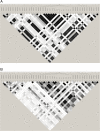A combination of two variants in PRKAG3 is needed for a positive effect on meat quality in pigs
- PMID: 24580963
- PMCID: PMC3943410
- DOI: 10.1186/1471-2156-15-29
A combination of two variants in PRKAG3 is needed for a positive effect on meat quality in pigs
Abstract
Background: Color and pH of meat measured 24 h post mortem are common selection objectives in pig breeding programs. Several amino acid substitutions in PRKAG3 have been associated with various meat quality traits. In our previous study ASGA0070625, a SNP next to PRKAG3, had the most significant association with meat quality traits in the Finnish Yorkshire. However, the known amino acid substitutions, including I199V, did not show any association. The aims of this study were to characterize further variation in PRKAG3 and its promoter region, and to test the association between these variants and the pH and color of pork meat.
Results: The data comprised of 220 Finnish Landrace and 230 Finnish Yorkshire artificial insemination boars with progeny information. We sequenced the coding and promoter region of PRKAG3 in these and in three additional wild boars. Genotypes from our previous genome-wide scans were also included in the data. Association between SNPs or haplotypes and meat quality traits (deregressed estimates of breeding values from Finnish national breeding value estimation for pH, color lightness and redness measured from loin or ham) was tested using a linear regression model. Sequencing revealed several novel amino acid substitutions in PRKAG3, including K24E, I41V, K131R, and P134L. Linkage disequilibrium was strong among the novel variants, SNPs in the promoter region and ASGA0070625, especially for the Yorkshire. The strongest associations were observed between ASGA0070625 and the SNPs in the promoter region and pH measured from loin in the Yorkshire and between I199V and pH measured from ham in the Landrace. In contrast, ASGA0070625 was not significantly associated with meat quality traits in the Landrace and I199V not in the Yorkshire. Haplotype analysis showed a significant association between a haplotype consisting of 199I and 24E alleles (or g.-157C or g.-58A alleles in the promoter region) and pH measured from loin and ham in both breeds (P-values varied from 1.72 × 10⁻⁴ to 1.80 × 10⁻⁸).
Conclusions: We conclude that haplotype g.-157C - g.-58A - 24E - 199I in PRKAG3 has a positive effect on meat quality in pigs. Our results are readily applicable for marker-assisted selection in pigs.
Figures


Similar articles
-
Genome-wide association studies (GWAS) identify a QTL close to PRKAG3 affecting meat pH and colour in crossbred commercial pigs.BMC Genet. 2015 Apr 7;16:33. doi: 10.1186/s12863-015-0192-1. BMC Genet. 2015. PMID: 25887635 Free PMC article.
-
SNP variation in the promoter of the PRKAG3 gene and association with meat quality traits in pig.BMC Genet. 2012 Jul 25;13:66. doi: 10.1186/1471-2156-13-66. BMC Genet. 2012. PMID: 22831392 Free PMC article.
-
Effects of single nucleotide polymorphisms and haplotypes of the protein kinase AMP-activated non-catalytic subunit gamma 3 (PRKAG3) gene on production, meat quality and carcass traits in Italian Large White pigs.Meat Sci. 2018 Feb;136:44-49. doi: 10.1016/j.meatsci.2017.09.012. Epub 2017 Sep 25. Meat Sci. 2018. PMID: 29096286
-
The application of gene marker-assisted selection and proteomics for the best meat quality criteria and body measurements in Qinchuan cattle breed.Mol Biol Rep. 2018 Oct;45(5):1445-1456. doi: 10.1007/s11033-018-4211-y. Epub 2018 Jul 13. Mol Biol Rep. 2018. PMID: 30006771 Review.
-
Saving genetic resources of native pigs in Occidental and Oriental countries - practical examples of the characterization and utilization of native pigs in Hungary and Laos.J Reprod Dev. 2013 Oct;59(5):437-41. doi: 10.1262/jrd.2013-055. J Reprod Dev. 2013. PMID: 24162808 Free PMC article. Review.
Cited by
-
Genome-wide association analysis reveals genetic loci and candidate genes for meat quality traits in Chinese Laiwu pigs.Mamm Genome. 2015 Apr;26(3-4):181-90. doi: 10.1007/s00335-015-9558-y. Epub 2015 Feb 13. Mamm Genome. 2015. PMID: 25678226
-
Genome-wide association analyses for meat quality traits in Chinese Erhualian pigs and a Western Duroc × (Landrace × Yorkshire) commercial population.Genet Sel Evol. 2015 May 12;47(1):44. doi: 10.1186/s12711-015-0120-x. Genet Sel Evol. 2015. PMID: 25962760 Free PMC article.
-
Genome-wide association studies (GWAS) identify a QTL close to PRKAG3 affecting meat pH and colour in crossbred commercial pigs.BMC Genet. 2015 Apr 7;16:33. doi: 10.1186/s12863-015-0192-1. BMC Genet. 2015. PMID: 25887635 Free PMC article.
-
Evidence for and localization of proposed causative variants in cattle and pig genomes.Genet Sel Evol. 2021 Aug 30;53(1):67. doi: 10.1186/s12711-021-00662-x. Genet Sel Evol. 2021. PMID: 34461824 Free PMC article. Review.
-
Whole-genome association analysis of pork meat pH revealed three significant regions and several potential genes in Finnish Yorkshire pigs.BMC Genet. 2017 Feb 13;18(1):13. doi: 10.1186/s12863-017-0482-x. BMC Genet. 2017. PMID: 28193157 Free PMC article.
References
-
- Sevón-Aimonen ML, Honkavaara M, Serenius T, Mäki-Tanila A, Puonti M. Genetic variation of loin and ham quality in Finnish Landrace and Large White pigs. Agric Food Sci. 2007;16:89–102. doi: 10.2137/145960607782219328. - DOI
-
- Moeller SJ, Miller RK, Edwards KK, Zerby HN, Logan KE, Aldredge TL, Stahl CA, Boggess M, Box-Steffensmeier JM. Consumer perceptions of pork eating quality as affected by pork quality attributes and end-point cooked temperature. Meat Sci. 2010;84:14–22. doi: 10.1016/j.meatsci.2009.06.023. - DOI - PubMed
-
- Sellier P. In: The Genetics of the Pig. 2. Rothschild MF, Ruvinsky A, editor. Chippenham, UK: CAB International; 2011. Genetics of meat and carcass traits; pp. 355–386.
-
- Milan D, Jeon JT, Looft C, Amarger V, Robic A, Thelander M, Rogel-Gaillard C, Paul S, Iannuccelli N, Rask L, Ronne H, Lundstrom K, Reinsch N, Gellin J, Kalm E, Roy PL, Chardon P, Andersson L. A mutation in PRK AG3 associated with excess glycogen content in pig skeletal muscle. Science. 2000;288:1248–1251. doi: 10.1126/science.288.5469.1248. - DOI - PubMed
Publication types
MeSH terms
Substances
LinkOut - more resources
Full Text Sources
Other Literature Sources

